Is It Safe to Eat Frozen Peas
Yes, it's safe to eat frozen peas. They're a nutritious and convenient option for your meals. Freezing preserves nutrients and inhibits bacterial growth, while reputable brands undergo rigorous quality control. Store them at 0°F (-18°C) or below to maintain safety. You can cook frozen peas directly from their frozen state, retaining texture and nutrition. They're an excellent source of vitamins C and K, fiber, and plant-based protein. Proper storage and handling are key to maintaining quality and safety. Whether you steam, microwave, or add them raw to dishes, frozen peas offer versatility and year-round availability. Explore various cooking methods and recipe ideas to maximize their benefits.
This post may contain affiliate links. If you make a purchase through these links, I may earn a commission at no additional cost to you. Additionally, portions of this post may be generated using artificial intelligence (AI) technology. While we strive for accuracy, please be aware that AI-generated content may not always be perfect and should be fact-checked when necessary.
The Spatula Scoops
- Frozen peas are generally safe to eat when stored and handled properly.
- Freezing preserves nutrients and inhibits bacterial growth, maintaining food safety.
- Reputable brands undergo rigorous quality control measures during processing.
- Frozen peas can be cooked directly from frozen, retaining texture and nutritional value.
- When stored at 0°F (-18°C) or below, frozen peas remain safe beyond their best-by date.
The Safety of Frozen Peas
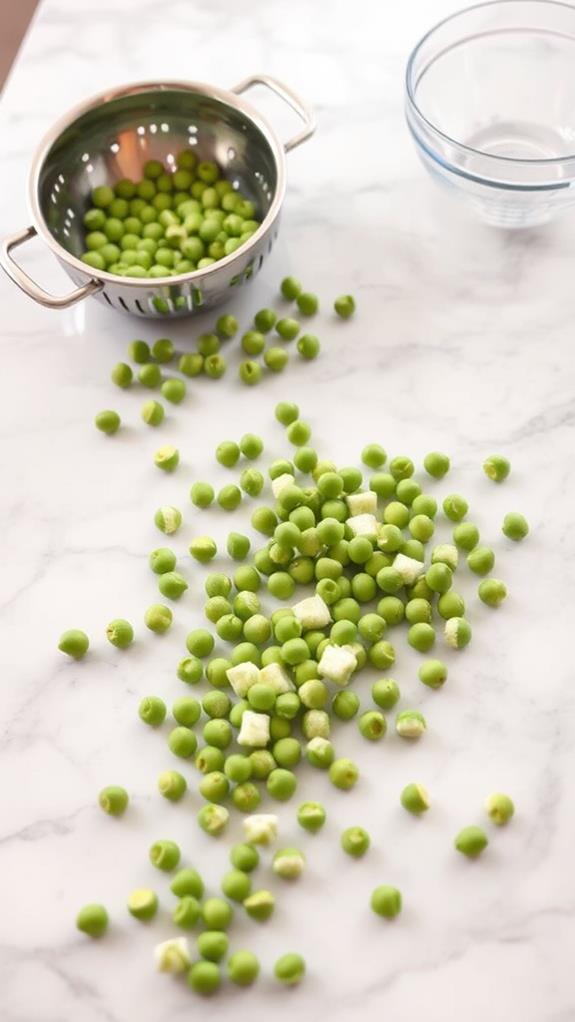
Frozen peas are generally safe to eat and can be a convenient and nutritious addition to your meals. The freezing process effectively preserves the peas' nutrients and flavor while inhibiting bacterial growth. When you purchase frozen peas from reputable sources, they've typically undergone rigorous quality control measures to guarantee food safety. Similar to chocolate's expiration date, the best-by date on frozen peas is more about quality than safety, and they can often be consumed well past this date if stored properly.
To maintain the safety of your frozen peas, you should store them at 0°F (-18°C) or below. This temperature prevents the growth of harmful microorganisms. When you're ready to use them, you can cook frozen peas directly from their frozen state without thawing. This practice helps retain their texture and nutritional value.
It's important to note that while frozen peas are safe, you should still follow proper food handling practices. Always check the package for any signs of damage or freezer burn. If you notice ice crystals or clumping, it may indicate that the peas have been partially thawed and refrozen, which can affect their quality and safety. Additionally, once you've opened the package, use the remaining peas within a few months for the best quality and safety.
Nutritional Benefits of Frozen Peas
Packed with essential nutrients, frozen peas offer a wealth of health benefits. They're an excellent source of vitamin C, which supports your immune system and helps with iron absorption. You'll also find significant amounts of vitamin K, indispensable for blood clotting and bone health. Frozen peas are rich in fiber, aiding digestion and promoting feelings of fullness. Similar to raw Brussels sprouts, frozen peas contain high levels of dietary fiber, which can support healthy digestion and gut health.
These little green powerhouses contain antioxidants, including flavonoids and carotenoids, which help protect your cells from damage. They're also a good source of plant-based protein, making them an ideal option for vegetarians and vegans. The folate in peas is essential for DNA synthesis and cell division, particularly important during pregnancy.
Frozen peas retain their nutritional value well due to the quick freezing process, which locks in nutrients shortly after harvesting. This means you're often getting more nutritional bang for your buck compared to fresh peas that have been transported and stored for longer periods. By incorporating frozen peas into your diet, you're adding a low-calorie, nutrient-dense food that can contribute to overall health and well-being.
Proper Storage and Handling
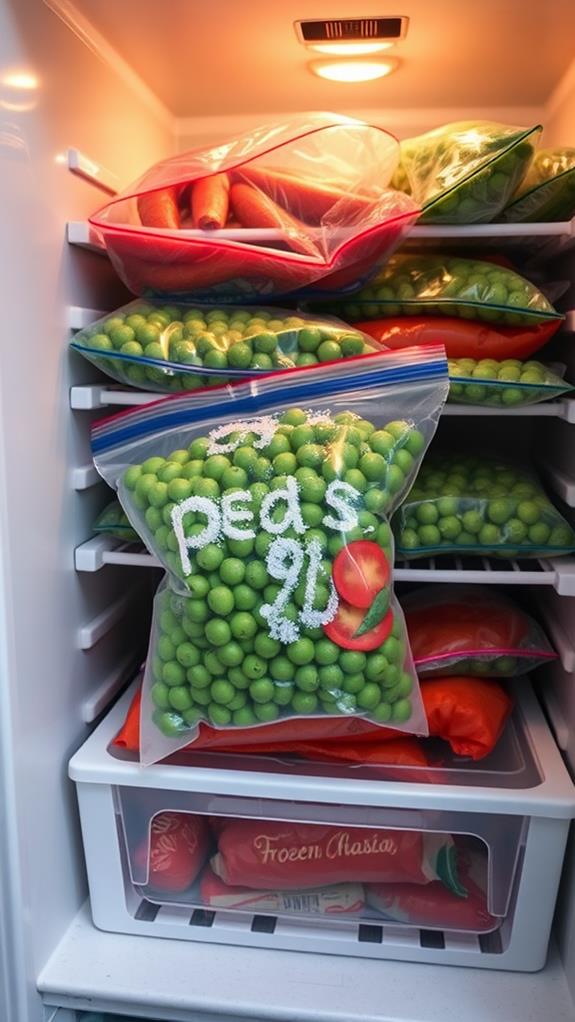
To guarantee your frozen peas remain safe and delicious, you'll need to pay attention to proper storage and handling techniques. First, keep your freezer at 0°F (-18°C) or below and store the peas towards the back, where temperatures are most consistent. For optimal organization and freshness, consider using airtight glass containers with measurement marks to store your frozen peas, which can help prevent freezer burn and make portion control easier. When it comes to thawing, it's best to use frozen peas directly in cooking or thaw them in the refrigerator, as repeated freezing and thawing can affect their quality and safety.
Freezer Temperature and Placement
When it comes to storing frozen peas, maintaining the right freezer temperature is vital. Your freezer should be set at 0°F (-18°C) or below to guarantee optimal preservation. Place your frozen peas in the back of the freezer, where the temperature remains most consistent, avoiding the door area where fluctuations occur.
To maximize the shelf life and quality of your frozen peas, consider these factors:
| Factor | Recommendation | Reason |
|---|---|---|
| Temperature | 0°F (-18°C) or below | Prevents ice crystal formation |
| Placement | Back of freezer | Maintains consistent temperature |
| Packaging | Airtight containers | Prevents freezer burn |
It's imperative to keep your freezer organized and not overfilled, as this allows for proper air circulation. If you've opened a bag of frozen peas, transfer the remaining peas to an airtight container or resealable freezer bag. Remove as much air as possible before sealing to prevent freezer burn.
Thawing and Refreezing Concerns
Proper storage is only half the battle when it comes to frozen peas. You'll need to be cautious about thawing and refreezing to maintain their quality and safety. When you're ready to use your peas, thaw them in the refrigerator or under cold running water. Avoid leaving them at room temperature, as this can encourage bacterial growth.
Once thawed, use your peas within 24 hours for the best taste and texture. If you've thawed more than you need, it's generally safe to refreeze them, but be aware that this may affect their quality. Repeated thawing and refreezing can lead to ice crystal formation, which can damage the peas' cell structure and result in a mushy texture.
To minimize waste and maintain quality, consider portioning your peas before freezing. This way, you can thaw only what you need. If you must refreeze thawed peas, do so quickly and make sure they haven't been left at room temperature for an extended period. Remember, proper handling is vital for food safety and preserving the nutritional value of your frozen peas.
Cooking Methods for Frozen Peas
When cooking frozen peas, you'll want to contemplate methods that preserve their nutritional value while ensuring quick and easy preparation. Steaming is an excellent option, as it retains more vitamins and minerals compared to boiling. If you're short on time, you can opt for microwave preparation, which offers convenience without sacrificing too much of the peas' nutritional content.
Steaming for Optimal Nutrition
Steaming stands out as a superior method for cooking frozen peas while preserving their nutritional value. When you steam frozen peas, you're using gentle heat and moisture to cook them, which helps retain more vitamins and minerals compared to other cooking methods. To steam frozen peas, you'll need a steamer basket or a colander that fits inside a pot with a lid.
Start by bringing about an inch of water to a boil in the pot. Place your frozen peas in the steamer basket or colander, ensuring they're not submerged in water. Cover the pot and let the steam do its work for about 3-5 minutes. You'll know they're done when they're bright green and tender.
Steaming offers several advantages. It's quick, easy, and doesn't require additional fats or oils. You'll preserve the peas' natural flavor and texture while maintaining their nutritional content. Steamed peas retain more vitamin C, B vitamins, and antioxidants compared to boiling or microwaving. This cooking method also helps maintain the peas' vibrant color, making them visually appealing on your plate.
Quick Microwave Preparation
For those short on time or kitchen equipment, microwaving offers a quick and convenient method to prepare frozen peas. To microwave frozen peas, you'll need a microwave-safe bowl and some water. Start by placing the frozen peas in the bowl and adding about a tablespoon of water for every cup of peas. This water helps create steam, ensuring even cooking.
Cover the bowl with a microwave-safe lid or plastic wrap, leaving a small vent for steam to escape. This technique, known as microwave steaming, helps retain the peas' nutrients and flavor. Set your microwave to high power and cook for about 2-4 minutes per cup of peas. Cooking times may vary depending on your microwave's wattage, so you'll want to check and stir the peas every minute.
Once done, carefully remove the bowl from the microwave using oven mitts. Be cautious of escaping steam when removing the cover. Drain any excess water and season the peas to taste. This method, while quick, may result in slightly less uniform cooking compared to stovetop methods. However, it's an excellent option for busy cooks seeking a fast, nutritious side dish.
Raw vs. Cooked Frozen Peas
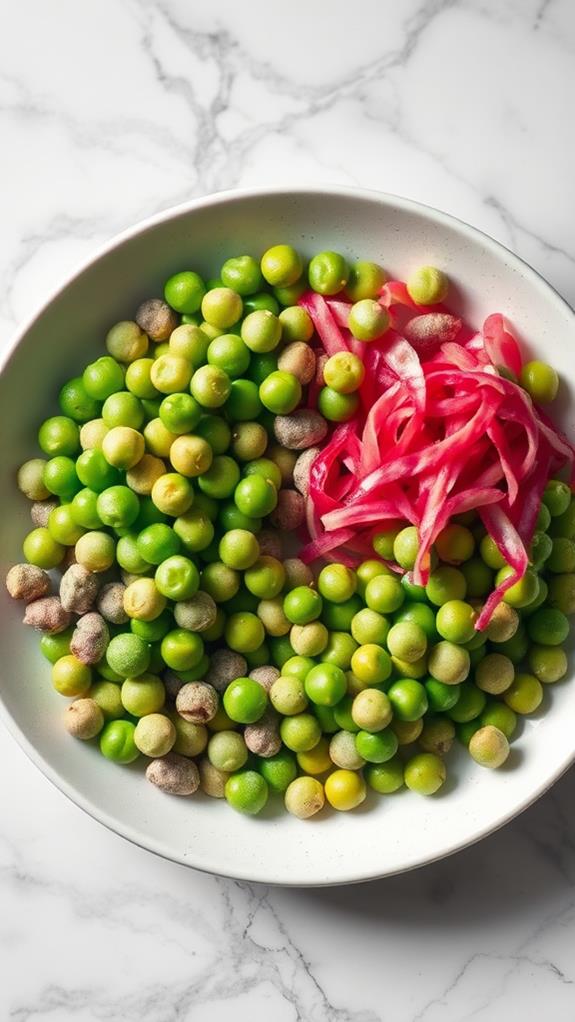
Many people wonder about the safety and taste differences between raw and cooked frozen peas. You can safely consume frozen peas both raw and cooked, but there are some key distinctions to ponder. Raw frozen peas offer a crisp texture and slightly sweeter flavor, while cooking them brings out a softer consistency and more mellow taste.
When it comes to nutritional value, both raw and cooked frozen peas have their benefits. However, cooking can affect certain nutrients. Here's a breakdown of the differences:
- Vitamin C: Raw peas retain more vitamin C, as heat can degrade this nutrient.
- Fiber: Cooking doesn't drastically impact fiber content.
- Protein: Heat can make proteins more digestible.
- Antioxidants: Some antioxidants become more bioavailable when cooked.
From a food safety perspective, frozen peas are typically blanched before freezing, which kills harmful bacteria. This process makes them safe to eat raw. However, if you're concerned about potential contamination, cooking provides an extra layer of protection. Ultimately, your choice between raw and cooked frozen peas depends on your taste preferences and specific nutritional goals.
Common Myths About Frozen Vegetables
While understanding the differences between raw and cooked frozen peas is important, it's equally valuable to dispel common misconceptions about frozen vegetables in general. You've probably heard that frozen vegetables are less nutritious than fresh ones, but this isn't always true. In fact, frozen veggies are often flash-frozen at peak ripeness, preserving their nutrients better than produce that's been shipped long distances.
Another myth you might encounter is that frozen vegetables contain harmful preservatives. However, most frozen vegetables are preserved through the freezing process alone, without added chemicals. You may also believe that all frozen vegetables need to be cooked, but as we've discussed with peas, this isn't always essential.
Some people think frozen vegetables are more expensive, but they can actually be more cost-effective, especially when certain produce is out of season. Ultimately, there's a misconception that frozen vegetables lack flavor. While texture can change, proper preparation can yield delicious results. By understanding these myths, you'll be better equipped to make informed decisions about incorporating frozen vegetables into your diet.
Comparing Fresh and Frozen Peas
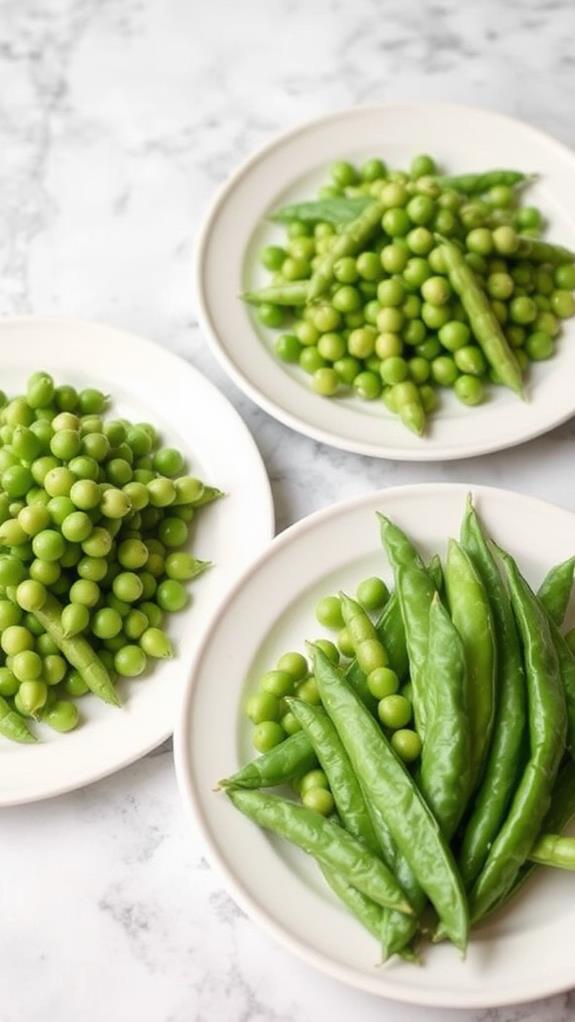
When you're deciding between fresh and frozen peas, you might wonder if there's a significant difference. Regarding nutrition, frozen peas often retain more vitamins and minerals than their fresh counterparts. This is because they're typically frozen shortly after harvesting, preserving their nutritional content.
Fresh peas, while delicious, can lose some of their nutrients during transportation and storage. However, they offer a superior texture and taste when eaten raw or lightly cooked. Frozen peas, on the other hand, provide convenience and year-round availability.
When comparing fresh and frozen peas, consider these factors:
- Nutritional value
- Taste and texture
- Convenience and shelf life
- Cost-effectiveness
With respect to SEO and content creation, using long-tail keywords like "fresh vs. frozen peas comparison" can improve your article's search engine ranking. Additionally, incorporating schema markup, a form of structured data, can help search engines better understand your content's context.
Ultimately, both fresh and frozen peas have their merits. Your choice may depend on factors such as availability, intended use, and personal preference. Remember, whether fresh or frozen, peas are a nutritious addition to your diet.
Incorporating Frozen Peas Into Meals
Now that we've compared fresh and frozen peas, let's explore how to make the most of those convenient frozen peas in your meals. You'll find that frozen peas are incredibly versatile and can be incorporated into a wide variety of dishes. To start, you can simply thaw them and add them to salads, pasta dishes, or rice bowls for a quick nutritional boost. For soups and stews, toss them in during the last few minutes of cooking to maintain their texture and color.
If you're looking for more creative options, try pureeing thawed peas with herbs and olive oil for a vibrant spread or dip. You can also use them as a base for homemade veggie burgers or fritters. For a quick side dish, sauté frozen peas with garlic and butter, or roast them in the oven with olive oil and seasonings for a crispy texture. Don't forget about using them in classic recipes like pot pies, shepherd's pie, or fried rice. By keeping frozen peas on hand, you'll always have a nutritious vegetable ready to enhance your meals.
Quality Control in Pea Processing
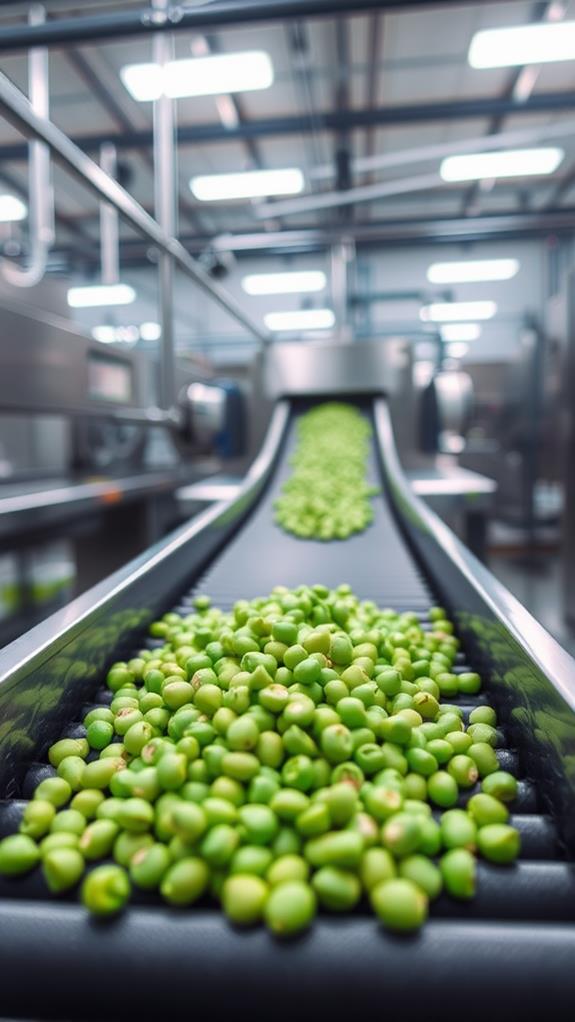
Quality control in pea processing involves several critical steps to ascertain the safety and quality of frozen peas. You'll find that processors adhere to strict standards throughout the entire production chain. From harvesting to packaging, each stage is carefully monitored to substantiate you're getting the best product possible.
The process typically includes:
- Field inspection: Checking for pests and diseases
- Harvesting at peak ripeness
- Rapid cooling and cleaning
- Blanching to preserve color and nutrients
After harvesting, peas are quickly transported to processing facilities where they're cleaned, sorted, and inspected for any defects. They're then blanched to inactivate enzymes that could cause spoilage. This step also helps retain the peas' vibrant green color and nutritional value.
You might be surprised to learn that frozen peas often have higher nutrient content than their fresh counterparts. That's because they're frozen at their peak freshness, locking in vitamins and minerals. Processors use quick-freezing techniques, such as individual quick freezing (IQF), to maintain the peas' texture and flavor.
Throughout the process, quality control measures include regular testing for contaminants, verifying proper temperatures are maintained, and validating packaging integrity.
Frequently Asked Questions
Can Dogs Eat Frozen Peas?
Yes, dogs can eat frozen peas safely. They're a nutritious, low-calorie treat that's rich in vitamins and minerals. You can offer them as a snack or mix them into your dog's regular food. However, it's important to introduce new foods gradually and in moderation. While frozen peas are generally safe, always monitor your dog for any adverse reactions. Remember, peas should be an occasional treat, not a main part of their diet. Consult your veterinarian if you have concerns about your dog's diet.
How Long Do Frozen Peas Last in the Freezer?
Frozen peas can last in your freezer for up to 12 months while maintaining their best quality. You'll find they're safe to eat beyond this time, but their texture and flavor may deteriorate. To maximize their shelf life, maintain they're stored at a constant 0°F (-18°C) or below. It's essential to keep them in airtight containers or freezer bags to prevent freezer burn. Always check for any signs of spoilage before consuming, even if they're within the recommended timeframe.
Are Frozen Peas Already Cooked Before Packaging?
Great Caesar's ghost! You might be surprised to learn that frozen peas aren't typically pre-cooked before packaging. They're flash-frozen shortly after harvesting, which preserves their nutrients and texture. This process, called individually quick frozen (IQF), involves blanching the peas briefly to deactivate enzymes, then rapidly freezing them. You'll need to cook them before eating, but don't worry—it's quick and easy. Just follow the package instructions for the best results.
Can You Refreeze Thawed Frozen Peas?
You can refreeze thawed frozen peas, but it's not ideal. When you thaw and refreeze, ice crystals form, potentially damaging the peas' texture and nutrient content. It's safe if you've thawed them properly in the refrigerator and haven't left them at room temperature for long. However, for the best quality, try to use thawed peas within a day or two. If you must refreeze, do it quickly and use them soon after to minimize quality loss.
Are There Any Pesticide Residues on Frozen Peas?
You might imagine pristine, pesticide-free peas nestled in their frozen cocoon, but reality isn't always so picture-perfect. While frozen peas generally have lower pesticide residues than fresh ones, they're not entirely free from chemicals. Freezing doesn't eliminate pesticides; it may preserve them. However, you shouldn't worry excessively. Regulatory bodies set strict limits on pesticide use, and processing methods often reduce residue levels. To minimize exposure, you can rinse your peas before cooking or opt for organic varieties when possible.
Conclusion
You've learned that frozen peas are safe and nutritious, coincidentally just as you were planning your next grocery trip. They're a convenient option, retaining nutrients when properly stored and prepared. Whether you choose to eat them raw or cooked, frozen peas offer versatility in your meals. Remember, while fresh peas have their merits, frozen varieties are often equally nutritious and more accessible year-round. As you incorporate frozen peas into your diet, you'll enjoy their benefits while dispelling common myths about frozen vegetables.





